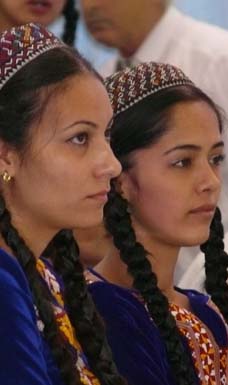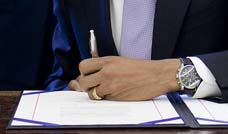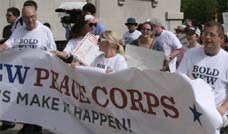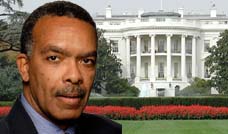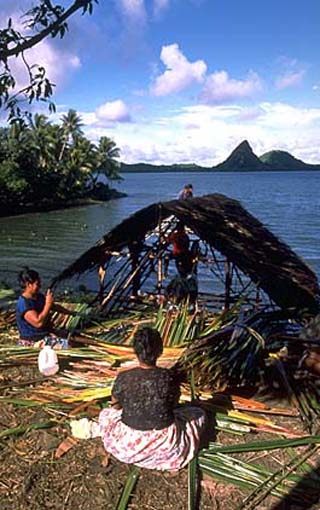
The US maintains a limited diplomatic presence throughout the region, having reduced its consular presence in the 1990s. After the 2007 PICL meetings the US opened a public diplomacy office in its embassy in Fiji, following the restoration of the Peace Corps regional office in Suva in 2004 (the US embassy in Fiji is the hub of its diplomatic presence in the PIF outside of Micronesia). There are currently approximately 350 Peace Corps volunteers serving in seven PIF nations. USAID programs also resumed, in limited fashion, in 2007, although most of the direct US aid outside of the FAS is directed towards disaster relief rather than poverty alleviation or nation-building. The latter are deemed to be the priority of US regional allies, Australia and New Zealand in particular. Beyond that, the US promotes anti-corruption and good governance initiatives on a case basis, often tying specific short-term assistance to transparency requirements. The Chinese have no such compulsion.
Paul G. Buchanan writes: The US reduced its diplomatic presence and withdrew most of its developmental assistance programmes in the South Pacific during the 1990s. This extended to elimination of the regional Peace Corps volunteer office and the withdrawal of USAID-directed poverty relief and developmental assistance efforts
The Giant's Rival, Part Two: The US Response
Monday, 21 September 2009, 9:17 am
Column: Paul G. Buchanan - A View From Afar
The Giant's Rival, Part Two: The US Response *
Paul G. Buchanan
21-09-09
China's emergence as a great power rival to the US in the South Pacific went unchallenged for a decade. For a number of reasons, the US reduced its diplomatic presence and withdrew most of its developmental assistance programmes in the South Pacific during the 1990s. This extended to elimination of the regional Peace Corps volunteer office and the withdrawal of USAID-directed poverty relief and developmental assistance efforts. Militarily, US attention remained concentrated on the North Pacific as a communications and transport corridor as well as a forward staging area for US power projection into East Asia. The US assumed that traditional allies Australia and New Zealand would take up the slack in developmental and security assistance as well as perform the maritime patrol duties requisite with keeping Southern Pacific sea-lanes open and Western influence predominant. The growing Chinese presence has belatedly altered that view.
[Excerpt]
The US signaled its attention to re-engage the South Pacific by announcing at the 2007 Pacific Island Conference of Leaders that year was to be "The Year of the Pacific." Although US rhetorical interest has not yet coalesced into a coherent South Pacific strategy, the latter has economic, military and political components involving direct and indirect forms of linkage. Before exploring these, mention must be made of the broader geo-strategic outlook in which the US response is situated.
Since the end of the Cold War, the US has construed the Western Pacific Rim as a three-tiered outer defense perimeter. The first line (or arc) extends from the Aleutians, through Japan, South Korea, Taiwan, the Philippines, Thailand, Singapore, Indonesia, Australia, New Zealand to the Ross Peninsula in Antarctica. Each of these locales has US military bases, US military personnel in country as advisors or instructors, or friendly military-to-military relations, and all participate in US intelligence gathering activities in areas of mutual interest. The relationship with individual countries ebbs and flows-witness Philippine and Japanese refusals to continue lease agreements for US military bases in Subic Bay, Clark Air Field and Okinawa, respectively, and the sometimes strained nature of US-Indonesian relations on human right issues and of US-New Zealand relations on the latter's non-nuclear stance. Even so, the overall contours of the perimeter have remained largely intact even with the end of the Cold War. What has changed is the nature of the perceived adversary.
The US holds a second defensive arc that runs from Hawaii through the Mariana and Marshall Islands, rooted in Guam, extending down to Australia. Here the US permanently stations military personnel and conducts front-line intelligence gathering, operational deployments, continuous exercises and forward logistical storage. This is the Pacific equivalent of a US Maginot Wall, where its presence in the Western Pacific geo-strategic space is at its most robust. It also serves as a trip wire for conflict escalation, as (impending) defeat in this battle space will likely entail US resort to tactical nuclear weapons.
The third defensive perimeter is a triangle that runs from the Aleutians to Hawaii to San Diego. It is the last line of defense before the US mainland, and if needed assets of the US Southern Command deployed in Central and South America will be drawn into it in order to reinforce those of the Pacific Command. It is an ultimate "shatter zone" in which the full range of US military power will be brought to bear on aggressors.
Although the latter is an improbable scenario, the Chinese second island chain objective brings it into direct contact with the US second defensive arc, and Chinese economic and diplomatic ventures are already prospering within it. This area of overlap is a potential conflict zone between the US and China. Given that reality, the US response to Chinese expansion within the second defensive perimeter is analytically dissected in order of priority, from least to most.
Soft Power initiatives:
Diplomatic approach.
The US has political authority over Guam, the Northern Marianas and American Samoa. It maintains close ties to the Freely Associated States (FAS--Marshall Islands, Federated States of Micronesia and Palau) and maintains military bases on Guam and the Kwajalein Atoll in the Marshall Islands. 60 per cent of the Marshall Islands' GDP comes from US aid and the direct economic benefits derived from the Reagan Ballistic Missile Test Site on Kwajalein. Via the Compacts of Free Association with the FAS, the US has the responsibility for defending the FAS but also the right, via the "defense veto" and the "right to strategic denial," to prohibit these states from engaging in activities injurious to US security. That includes establishing diplomatic, commercial, or military ties with potential adversaries.
Otherwise the US maintains a limited diplomatic presence throughout the region, having reduced its consular presence in the 1990s. After the 2007 PICL meetings the US opened a public diplomacy office in its embassy in Fiji, following the restoration of the Peace Corps regional office in Suva in 2004 (the US embassy in Fiji is the hub of its diplomatic presence in the PIF outside of Micronesia). There are currently approximately 350 Peace Corps volunteers serving in seven PIF nations. USAID programs also resumed, in limited fashion, in 2007, although most of the direct US aid outside of the FAS is directed towards disaster relief rather than poverty alleviation or nation-building. The latter are deemed to be the priority of US regional allies, Australia and New Zealand in particular. Beyond that, the US promotes anti-corruption and good governance initiatives on a case basis, often tying specific short-term assistance to transparency requirements. The Chinese have no such compulsion.
The main thrust of the US diplomatic approach emphasizes "partnerships" with its small island counterparts, not only in terms of military-to-military relations but also on a wide range of subjects of mutual interest, to include environmental degradation resultant from climate change, resource sustainability, pandemic relief, state building and governmental accountability. In this measure it seeks to strengthen its ties to local authorities while not having to confront them directly with regards to the Chinese presence. This allows the Chinese to do most of the "hard lifting" when it comes to regional development, but without the full diplomatic benefits such assistance would otherwise accrue. The idea is to subtly counter Chinese moves to realign the PIF in accord with its diplomatic and military interests.
Economic approach.
Although the South Pacific remains a low priority to US policy makers, they have revived limited country-to-country aid programmes. However, the thrust of the US approach is defensive rather than developmentalist. The major concern of the US is with money laundering, black market document sales and the presence of organized crime as a facilitator to terrorist organizations or their front agencies. It has consequently worked hardest to tighten PIF compliance with international banking regulations and standards restricting "shell" entities from hiding or transferring funds using PIF banks, as well as to increase the sophistication of local Police forces when dealing with the economic activities of foreign crime syndicates.
The Republic of the Marshall Islands (RMI) received US$1 billion in direct US aid from 1987 to 2003, while the Federated States of Micronesia (FSM) received approximately US$1.5 billion. In 2003 the US signed into law grant assistance packages for the period 2004-2023 totaling US$629 million and US$1.4 billion to the RMI and FSM respectively. Palau received US$450 million in direct economic assistance from 1995 to 2009. Of the total of US$ 887 million in direct foreign aid to Pacific island countries in 2006, the US provided US$140 million, of which US$131 million went to the FAS. The US also pays the RMI US$15 million per year for leasing the Kwajalein test site (rising to US$18 million/year in 2014). According to the US Congressional Research Service, as part of the Compacts, the United States agreed to support the FAS economically with the goal of making them self-sufficient. The FAS are eligible for many U.S. federal programs, while FAS citizens have the right to reside and work in the United States and its territories as lawful non-immigrants or "habitual residents."
Other major U.S. foreign aid programs in the Pacific Islands region include the Pacific Island Fund ($100,000 in FY2006), supporting small projects developed by U.S. ambassadors in their host countries; South Pacific Fisheries (about $18 million annually); HIV/AIDS programs in Papua New Guinea ($1.5 million per year); and environmental programs (particularly coral reef conservation and environmental research), with budgetary supplementation from agencies such as the National Oceanic and Atmospheric Administration (NOAA). Where not specified, the amounts designated for each depend on Congressional budgetary priorities, which militates against significant increases given the current fiscal climate. As a result, and even with the purported re-emphasis on the Pacific announced in 2007, the total volume of US aid to the PIF has remained constant and well behind that of Australia, New Zealand, Japan and China.
Out of a total PIF world trade volume of US$8.279 billion in 2005, trade between the US and the PIF amounted to US$ 3.93 billion, the majority of which was with Fiji and Papua New Guinea. This puts it behind Australia, the EU, Japan, and China in terms of bilateral trade volume. The combined impact of US direct foreign aid and trade with the region outside of the FAS is therefore minimal when compared with that of China and other states. In spite of its rhetorical commitment to reinvigorating its commercial ties to the region, the US has preferred to allow others to take the lead while it concentrates its resources elsewhere.








